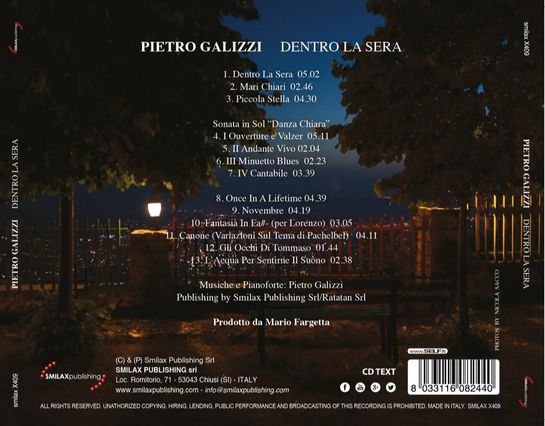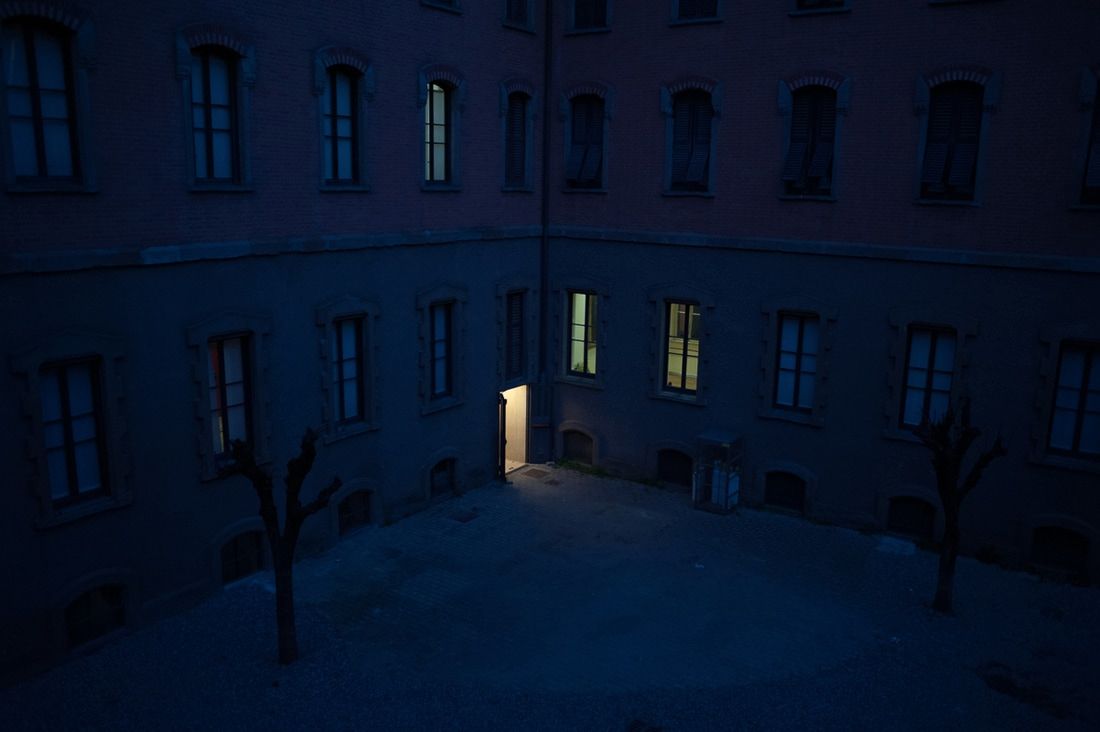Discography
|
|
DENTRO LA SERA
Pietro's first solo album. Produced by Mario Fargetta, recorded by Antonio Bonazzo at Wave Music Lab - Milano, published by Smilax Publishing. Music & Piano: Pietro Galizzi. --- Il primo album di Pietro come solista. Prodotto da Mario Fargetta, registrato da Antonio Bonazzo presso il Wave Music Lab di Milano, pubblicato dalla Smilax Publishing. Musiche e Pianoforte: Pietro Galizzi. --- Tracks 1. Dentro la Sera 5.02 2. Mari Chiari 2.46 3. Piccola Stella 4.30 Sonata in Sol "Danza Chiara" 4. I - Ouverture e Valzer 5.11 5. II - Andante Vivo 2.04 6. III - Minuetto Blues 2.23 7. IV - Cantabile 3.39 8. Once In A Lifetime 4.39 9. Novembre 3.05 10. Fantasia in Fa#- (per Lorenzo) 4.19 11. Canone (Variazioni sul Tema di Pachelbel) 4.11 12. Gli Occhi di Tommaso 1.44 13. L'Acqua Per Sentirne Il Suono 2.38 |
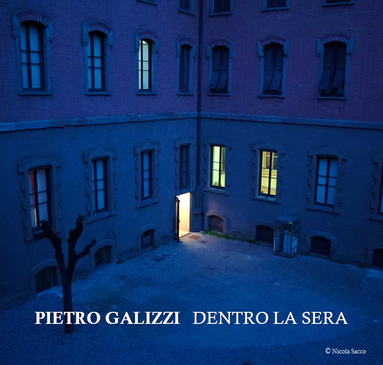
DENTRO LA SERA (5.02)
Twilight, it’s almost dark; a thoughtful and relaxed silence. A door opens and, suddenly, a light shines into the picture, penetrating the atmosphere and bringing a luminous ray with it.
This is a piece in A minor which I wrote in March 2016, partly in Noceto (Parma – Italy) and partly in Milano (Italy), in the Naviglio Grande area. It is a piece which I always play when I am waiting in the departures/arrivals area of the Rome Fiumicino Airport, where there is a Ciampi piano which everybody can use.
Penombra, quasi buio, un silenzio assorto e rilassato. Una porta si apre e, improvvisa, una luce fa il suo ingresso, penetrando l’atmosfera.
E’ un brano in La minore del marzo 2016, scritto tra Noceto (Parma) e Milano, Naviglio Grande.
Un mio classico, quando transito nel corridoio B delle partenze/arrivi dell'aeroporto di Roma Fiumicino, e mi fermo a suonare sul pianoforte Ciampi che si trova lì, a disposizione di chi passa.
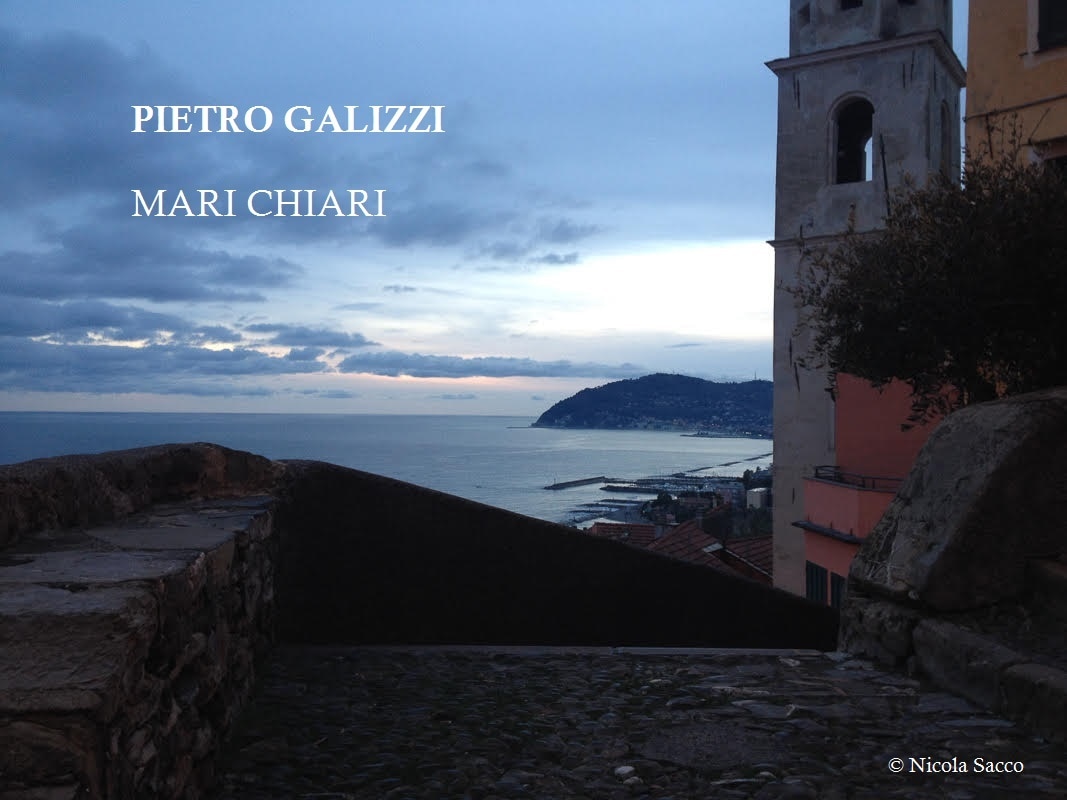
MARI CHIARI (2.46)
An incessant arpeggio, like waves. This was written in March 2016, in Milan, in G minor. The main theme is clearly indicated by the highest notes.
A friend of mine told me that he regularly uses this music to create the right atmosphere, appropriate for a candle light dinner for two, at home; I am happy to be of some help.
Un arpeggio ripetuto, come le onde. Scritto nel marzo 2016, a Milano, in Sol minore, lascia emergere il tema quando tocca le note alte.
Un amico mi ha raccontato di usarlo puntualmente, per creare l’atmosfera, adatta ad una cena a lume di candela, a casa, per due: happy to be of some help.
MARI CHIARI (2.46)
An incessant arpeggio, like waves. This was written in March 2016, in Milan, in G minor. The main theme is clearly indicated by the highest notes.
A friend of mine told me that he regularly uses this music to create the right atmosphere, appropriate for a candle light dinner for two, at home; I am happy to be of some help.
Un arpeggio ripetuto, come le onde. Scritto nel marzo 2016, a Milano, in Sol minore, lascia emergere il tema quando tocca le note alte.
Un amico mi ha raccontato di usarlo puntualmente, per creare l’atmosfera, adatta ad una cena a lume di candela, a casa, per due: happy to be of some help.
|
Mari Chiari |
PICCOLA STELLA (4.20)
This was inspired by Piccola Stella Senza Cielo, a fantastic song by Luciano Ligabue. It uses the same basic chords as Luciano’s song. It was written in July 2016. Piccola Stella Senza Cielo is a song which I always play when I have a guitar with me. Similarly, Piccola Stella is a track which I often play when I find a piano in a public area. It easily attracts people’s attention both the easy harmonies and the relative speed of some arpeggio. “You will show yourself, and we will get mesmerized…” (free translation from a few words of Piccola Stella Senza Cielo, by Luciano Ligabue)
Ispirata al brano Piccola Stella Senza Cielo, di Luciano Ligabue, della quale sfrutta in parte il giro di accordi di base. Scritta nel luglio 2016. Piccola Stella Senza Cielo è per me un classico, quando ho una chitarra in mano, e analogamente Piccola Stella è a sua volta un brano che suono spesso quando incontro un pianoforte in luoghi pubblici, catturando facilmente l’attenzione sia per le armonie sia per la (relativa) velocità di alcuni arpeggi.
“Ti mostrerai, ci incanteremo…” (da Piccola Stella Senza Cielo, di Luciano Ligabue).
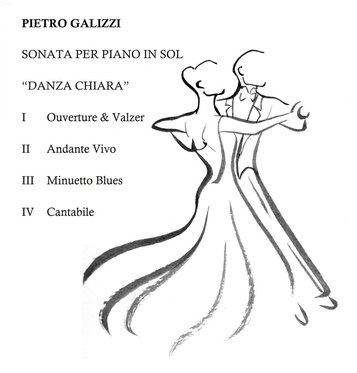
SONATA IN SOL “DANZA CHIARA”
I - Ouverture & Valzer (5.11)
II - Andante Vivo (2.04)
III- Minuetto Blues (2.23)
IV - Cantabile (3.39)
This is a piano sonata with four pieces, out of which three are in G (Ouverture and Valzer, Andante Vivo and Cantabile) and one is in G minor (Minuetto Blues: a bit of minuetto, some more of blues).
I wrote it between January and February 2016. This Sonata made me think that, after a number of years during which I had not played at all (while my kids were growing), maybe my music still had something to say?
Often, when I play the valzers (first and fourth piece) I think about my grandma, who played piano and loved classical music. I am sure that she would have loved them.
Andante Vivo is, for me, pure relaxation and Minuetto Blues is pure amusement.
Una sonata con quattro brani, dei quali tre in Sol maggiore (Ouverture e Valzer, Andante Vivo e Cantabile) e uno in Sol minore (Minuetto Blues: poco minuetto, un poco più blues).
Scritta tra il gennaio e il febbraio 2016, è la sonata che mi ha convinto che, forse, dopo tanti anni passati senza quasi suonare (mentre i figli crescevano), avevo ancora qualcosa da dire.
Spesso, quando suono i valzer (il primo e il quarto brano) mi viene in mente la mia nonna materna, che suonava il pianoforte e amava immensamente la musica classica: sono sicuro che li avrebbe apprezzati.
Andante Vivo è invece, per me, un momento di vero relax; Minuetto Blues puro divertimento.
ONCE IN A LIFETIME (4.39)
This is a piece in F# minor which I wrote in September 2016. It starts quietly and gets dynamic… in the final part.
There are people you meet, and experiences you enjoy, only once in your lifetime.
This piece is dedicated to them, as an acknowledgment that they exist, and as a thank you.
With the desire that the memory of that moment, or person, will never leave you.
Un brano in Fa# minore, scritto nel settembre 2016, che nasce calmo e si vivacizza nella parte finale.
Vi sono persone, o esperienze, che si incontrano e vivono una volta nella vita. Once In A Lifetime è dedicata a loro, alla consapevolezza che esistono, al ringraziamento che ne consegue, e al desiderio di non privarsi mai del ricordo di quanto quel momento o quella persona ci abbiano fatto vivere.
FANTASIA IN FA#- (4.19)
This is a fantasia which starts impetuously, in 4/4, with strong chords and incessant arpeggios, and develops into a sort of valzer, changing to 3/4.
I wrote it in October 2007, to celebrate the 40th birthday of my friend Lorenzo, a magic guitar player with whom we shared a number of beautiful and significant pages of my short music experience.
Una fantasia che nasce impetuosa, in 4/4, con accordi forti e arpeggi che si susseguono, e nella parte centrale si sviluppa in una sorta di valzer, modificando il tempo in 3/4.
Scritta nell’ottobre 2007, per festeggiare i 40 anni del mio amico Lorenzo, magico chitarrista con il quale ho suonato tantissimo e condiviso pagine tra le più belle e significative della mia breve storia musicale.
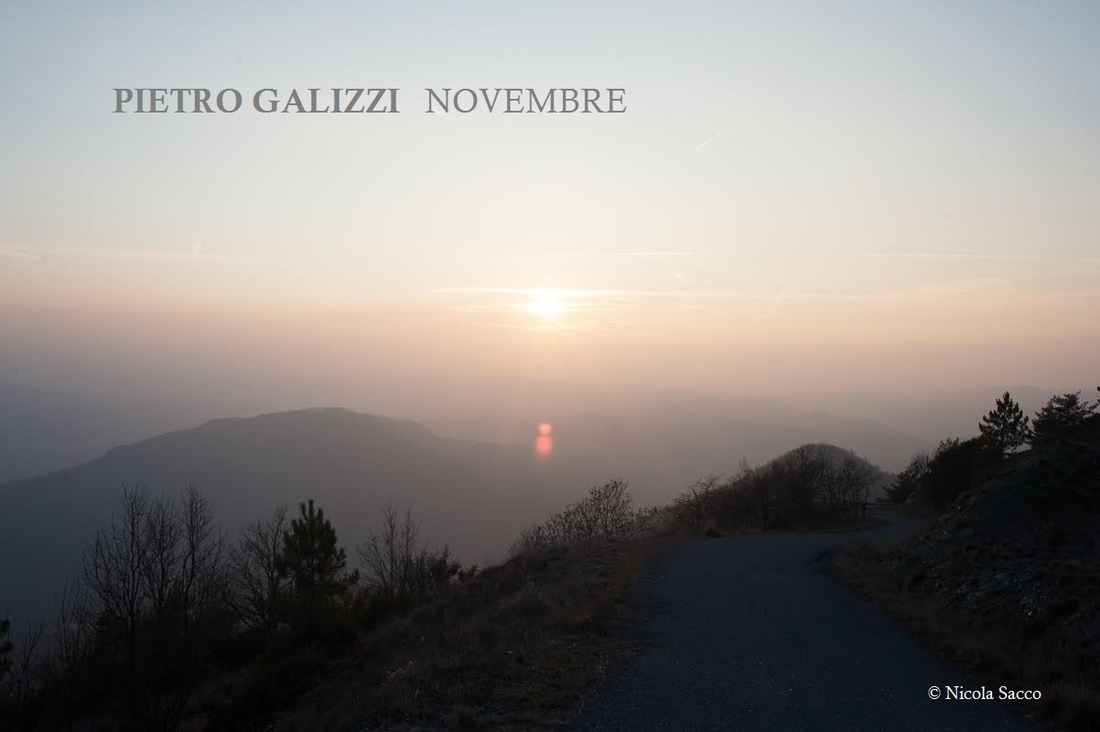
NOVEMBRE (3.05)
Novembre is the emotion which strongly vibrated under your skin, touched every single centimetre of your body, made it alive and kicking, and now leaves you with a quiet taste to enjoy.
This is a track which has always been with me, marking material moments of my life.
Novembre è l’emozione che ha vibrato fortemente sotto la tua pelle, ha toccato ogni angolo del tuo corpo, lo ha reso vivo e sconvolto, e ora ti lascia una quiete, e un ricordo, da gustare e assaporare.
È un brano che mi ha sempre accompagnato, segnando momenti importanti della mia vita.
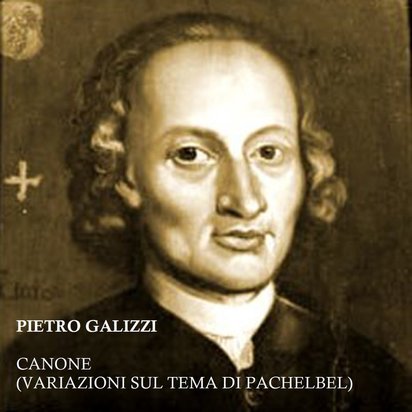
CANONE (VARIAZIONI SUL TEMA DI PACHELBEL) (4.11)
Pachelbel Canon is an absolute classic, since the 17th century.
I still remember that, when I was eleven and I had just started my studies at the Conservatorio “Nicolini”, in my hometown Piacenza (Italy), my mother gave me as a gift an audiotape which included, among the others, the Air on the G String by Bach and the Pachelbel Canon. It was the version for chamber orchestra by Jean-François Paillard. It is a very quiet version, where the basso continuo is incessant and the three voices can be clearly distinguished. I immediately fell in love with it.
Along the years I noticed that a number of pieces and songs are based on the chords of the Canon: D A B- F#- G D M- A. Among the others we can name the main theme from the Pomp & Circumstance March no. 1 by Sir Edward Elgar, Albachiara by Vasco Rossi, the refrain from Questo Piccolo Grande Amore by Claudio Baglioni, the one from Symbolum ’80 by Pierangelo Sequeri, I’ll C U When U Get There by Coolio and Feuielle d’Automne by Indila (the last two are explicitly based on the Canon).
My variations come from an idea by George Winston, a great pianist who published with Windam Hill: do not worry, if you will tell me this, I will not get offended.
Il Canone di Pachelbel è un assoluto classico, dalla fine del XVII secolo.
Ricordo ancora quando, ai tempi della scuola media, da poco avevo iniziato gli studi presso il Conservatorio “Nicolini” di Piacenza e mia madre mi regalò una audiocassetta che comprendeva, tra gli altri, l’Aria Sulla IV Corda di Bach e il Canone di Pachelbel, nella versione orchestrale di Jean-François Paillard.
Si tratta di una versione del Canone tranquilla (non frenetica, come invece sono la maggior parte delle versioni che sono state registrate nel corso degli anni), dove il basso continuo è valorizzato e le tre voci sono chiaramente distinguibili. Me ne innamorai immediatamente. Negli anni mi sono poi reso conto come un numero infinito di brani e canzoni, più o meno note, siano basate sul giro di accordi del Canone: Re La Si- Fa#- Sol Re Mi- La (anche se trasposto in altra tonalità o con minime variazioni). Tra i vari, mi basti citare il tema della Pomp & Circumstance March n.1 di Sir Edward Elgar, Albachiara di Vasco Rossi, il refrain di Questo Piccolo Grande Amore di Claudio Baglioni, quello di Symbolum ’80 di Pierangelo Sequeri, fino ad arrivare a I’ll C U When U Get There di Coolio e Feuille d’Automne di Indila (queste ultime citano esplicitamente il Canone).
Le mie variazioni nascono da un’idea di George Winston, bravissimo pianista che ha pubblicato con Windam Hill: non preoccupatevi, non mi offenderei se me lo faceste notare.
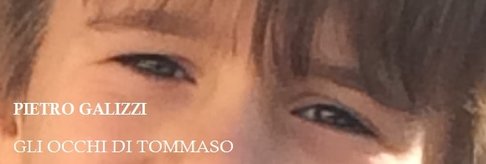
GLI OCCHI DI TOMMASO (1.44)
Happiness, continuous inventions, desire of living, creating and undoing: this is Tommaso, one of my two kids, and this is what I wanted to share with this piece in G, which I wrote in November 2016.
It reminds one of a classical music piece, and could be played with a cembalo.
Of course my next album will have to start with music dedicated to Edoardo.
Vivacità, invenzioni continue, voglia di vivere, fare e disfare: così è Tommaso, uno dei miei figli, e questo ho voluto rappresentare con un brano in Sol maggiore del novembre 2016, classicheggiante, che potrebbe tranquillamente essere suonato con un clavicembalo.
Naturalmente, il prossimo album non potrà non iniziare che con un brano dedicato a Edoardo ;)
L’ACQUA PER SENTIRNE IL SUONO (2.38)
A desperate need for love, as Stadio (an Italian rock band) would say. This is the piano version of a song which I wrote in 1989. I particularly care about this piece, which my mom loved. It is in Ab, with a D bequadro which creates a certain harmonization.
This is the translation of my 1989 song:
“I would like to feel the warm earth
And listen to people talking to me
A few vibrant steps
Friendly and whispering voices
And listen to the sound of water
The perfume of a friendly woman
Your words
Her love
I would like to see everything again
As I lived it with you
I notice in a number of clear eyes
The same gaze
Sometimes I feel tired
I feel that I am losing myself
I do not know any longer
Whether when I talked to you
I was fool
I would like to feel
The perfume of fresh grass
Few and silent words
Coldness is dying
And listen to the sound of water
The perfume of a friendly woman
Her words
Your love
Her gaze
I would like to find again
My will
Which I forgot"
È la versione strumentale, riadattata, di una mia canzone del 1989. È un brano al quale tengo moltissimo, che mia madre amava, basato su un arpeggio in Lab maggiore, con un Re bequadro a creare la differenza.
Questo il testo della canzone:
“Vorrei sentire terra calda
e chi mi parla
passi scarni ma vivaci
voci amiche soffuse
E l’acqua per sentirne il suono
il profumo di una donna amica
le sue parole
il Tuo amore.
Vorrei vedere ancora tutto
come con Te ho vissuto
e scorgo in tanti occhi chiari
lo stesso sguardo
A volte non ne ho più la forza
e sento che mi sto perdendo
non so più
se quando Ti ho parlato
non ero illuso.
Vorrei sentire il profumo
dell’erba fresca
parole parche, silenziose
il freddo muore
E l’acqua per sentirne il suono
il profumo di una donna amica
le sue parole
il Tuo amore
il suo sguardo.
Vorrei ancora qui
la mia volontà
che non so più."
Main photos in these web pages (including album cover and back cover) by Nicola Sacco.
Le principali fotografie su questo sito, comprese le immagini di copertina dell'album, sono di Nicola Sacco.
Le principali fotografie su questo sito, comprese le immagini di copertina dell'album, sono di Nicola Sacco.
